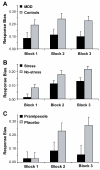Depression, stress, and anhedonia: toward a synthesis and integrated model
- PMID: 24471371
- PMCID: PMC3972338
- DOI: 10.1146/annurev-clinpsy-050212-185606
Depression, stress, and anhedonia: toward a synthesis and integrated model
Abstract
Depression is a significant public health problem, but its etiology and pathophysiology remain poorly understood. Such incomplete understanding likely arises from the fact that depression encompasses a heterogeneous set of disorders. To overcome these limitations, renewed interest in intermediate phenotypes (endophenotypes) has resurfaced, and anhedonia has emerged as one of the most promising endophenotypes of depression. Here, a heuristic model is presented postulating that anhedonia arises from dysfunctional interactions between stress and brain reward systems. To this end, we review and integrate three bodies of independent literature investigating the role of (a) anhedonia, (b) dopamine, and (c) stress in depression. In a fourth section, we summarize animal data indicating that stress negatively affects mesocorticolimbic dopaminergic pathways critically implicated in incentive motivation and reinforcement learning. In the last section, we provide a synthesis of these four literatures, present initial evidence consistent with our model, and discuss directions for future research.
Figures



References
-
- Abercrombie ED, Keefe KA, DiFrischia DS, Zigmond MJ. Differential effect of stress on in vivo dopamine release in striatum, nucleus accumbens, and medial frontal cortex. J. Neurochem. 1989;52:1655–8. - PubMed
-
- American Psychiatric Association . Diagnostic and statistical manual of mental disorders. 4th. American Psychiatric Press; Washington, DC: 2000. text revision.
-
- Amital D, Fostick L, Silberman A, Beckman M, Spivak B. Serious life events among resistant and non-resistant MDD patients. J. Affect. Disord. 2008;110:260–264. - PubMed
-
- Bagot RC, Meaney MJ. Epigenetics and the biological basis of Gene x Environment interactions. J. Am. Acad. Child Adol. Psychiatry. 2010;49:752–71. - PubMed
Publication types
MeSH terms
Grants and funding
LinkOut - more resources
Full Text Sources
Other Literature Sources
Medical

